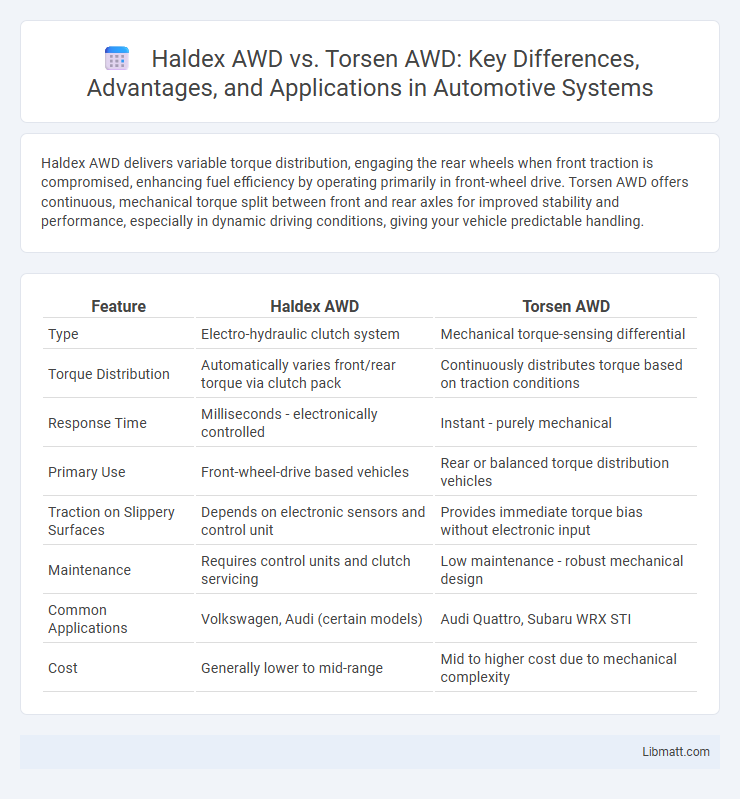Haldex AWD delivers variable torque distribution, engaging the rear wheels when front traction is compromised, enhancing fuel efficiency by operating primarily in front-wheel drive. Torsen AWD offers continuous, mechanical torque split between front and rear axles for improved stability and performance, especially in dynamic driving conditions, giving your vehicle predictable handling.
Table of Comparison
| Feature | Haldex AWD | Torsen AWD |
|---|---|---|
| Type | Electro-hydraulic clutch system | Mechanical torque-sensing differential |
| Torque Distribution | Automatically varies front/rear torque via clutch pack | Continuously distributes torque based on traction conditions |
| Response Time | Milliseconds - electronically controlled | Instant - purely mechanical |
| Primary Use | Front-wheel-drive based vehicles | Rear or balanced torque distribution vehicles |
| Traction on Slippery Surfaces | Depends on electronic sensors and control unit | Provides immediate torque bias without electronic input |
| Maintenance | Requires control units and clutch servicing | Low maintenance - robust mechanical design |
| Common Applications | Volkswagen, Audi (certain models) | Audi Quattro, Subaru WRX STI |
| Cost | Generally lower to mid-range | Mid to higher cost due to mechanical complexity |
Introduction to AWD Systems
Haldex AWD systems utilize an electronically controlled hydraulic clutch to distribute torque dynamically between the front and rear axles, improving traction and stability. Torsen AWD employs a mechanical gear-based limited-slip differential that automatically adjusts torque distribution based on wheel grip without electronic intervention. Understanding the differences in these AWD types helps you select the optimal system for your vehicle's performance and driving conditions.
What is Haldex AWD?
Haldex AWD is an all-wheel-drive system that uses an electronically controlled hydraulic clutch to distribute torque between the front and rear wheels, enhancing traction and stability. Unlike traditional mechanical systems like Torsen AWD, Haldex reacts dynamically to changing road conditions by adjusting torque allocation in real-time. Your vehicle benefits from improved handling and efficiency with Haldex AWD's ability to seamlessly engage all four wheels when needed.
What is Torsen AWD?
Torsen AWD is a type of all-wheel-drive system that uses a torque-sensing differential to distribute power between the front and rear axles based on traction conditions. It actively transfers torque to the axle with the most grip, enhancing stability and handling without electronic intervention. This mechanical system is known for its quick response and durability, commonly found in performance and off-road vehicles.
Core Technology Comparison
Haldex AWD uses an electronically controlled hydraulic clutch system that dynamically distributes torque between the front and rear axles based on real-time traction needs, optimizing grip on varying road conditions. In contrast, Torsen AWD relies on a purely mechanical, gear-based limited-slip differential that automatically biases torque toward the wheels with the most traction without electronic intervention. The Haldex system offers faster response times and greater adaptability in hybrid or front-wheel-drive platforms, while Torsen provides robust, continuous torque distribution ideal for performance and off-road vehicles.
Performance in Different Driving Conditions
Haldex AWD systems excel in varying traction scenarios by actively distributing torque between the front and rear axles, enhancing stability on slippery or uneven surfaces. Torsen AWD relies on a mechanical limited-slip differential that continuously provides torque biasing, offering superior performance on dry pavement and during high-speed cornering. Both systems improve handling and safety but Haldex adapts more dynamically to changing road conditions, whereas Torsen delivers consistent torque distribution for performance-oriented driving.
Efficiency and Fuel Consumption
Haldex AWD systems primarily engage the rear wheels only when slip is detected, optimizing fuel efficiency by operating mostly in front-wheel drive mode during normal conditions. Torsen AWD delivers continuous torque distribution between front and rear axles, which can lead to higher fuel consumption due to constant engagement of all wheels. Vehicles equipped with Haldex AWD typically achieve better fuel economy compared to those with Torsen differentials, especially in urban driving and light-load scenarios.
Maintenance and Reliability
Haldex AWD systems typically require regular maintenance, including fluid changes every 30,000 to 40,000 miles to ensure optimal performance and longevity, while Torsen AWD systems are mostly maintenance-free due to their mechanical design. Reliability-wise, Torsen systems are known for durable, long-lasting operation with fewer components that can fail, making them ideal for drivers seeking a low-maintenance AWD solution. Your choice depends on whether you prefer a system with potentially higher maintenance but active torque distribution (Haldex) or a more robust, passive system (Torsen) with minimal upkeep.
Vehicle Applications and Market Presence
Haldex AWD systems are predominantly used in compact and midsize vehicles from manufacturers like Volkswagen, Audi, and Ford, offering versatility in passenger cars and light SUVs. Torsen AWD is commonly found in performance and luxury vehicles from brands such as Audi Quattro models, Lexus, and Toyota, renowned for its mechanical torque-sensing capabilities ideal for sporty driving. Your choice depends on whether you prioritize all-weather versatility typical of Haldex or the dynamic handling advantages associated with Torsen-driven vehicles.
Pros and Cons of Haldex AWD
Haldex AWD offers quick, on-demand power distribution between front and rear wheels, improving fuel efficiency by primarily operating in front-wheel drive mode. Its electronic control system excels in adapting to varying road conditions but can be more complex and costly to repair compared to mechanical AWD systems. However, Haldex may experience a slight delay in power transfer, reducing traction performance during sudden slippage situations compared to the immediate torque split of Torsen AWD.
Pros and Cons of Torsen AWD
Torsen AWD systems offer precise torque distribution and superior handling on dry and slippery surfaces due to their mechanical, gear-based design, which enhances traction without relying on electronic controls. However, Torsen diffs can struggle in low-traction scenarios where both wheels lose grip simultaneously, limiting effectiveness compared to AWD systems with electronic intervention. Your driving experience benefits from Torsen's immediate response and durability, but it may lack versatility in extreme off-road or icy conditions.
Haldex AWD vs Torsen AWD Infographic

 libmatt.com
libmatt.com